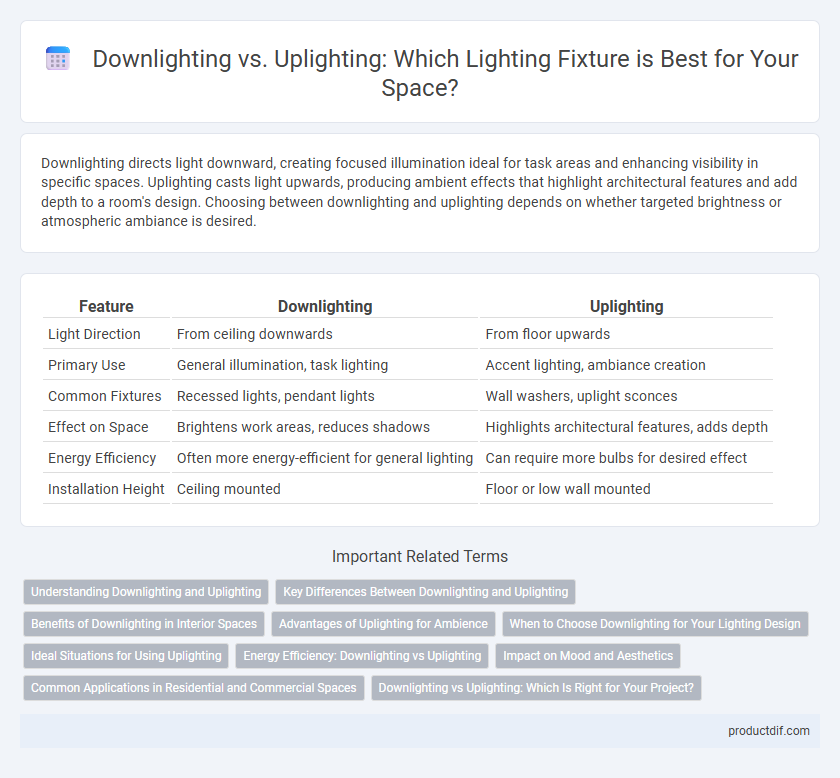Downlighting directs light downward, creating focused illumination ideal for task areas and enhancing visibility in specific spaces. Uplighting casts light upwards, producing ambient effects that highlight architectural features and add depth to a room's design. Choosing between downlighting and uplighting depends on whether targeted brightness or atmospheric ambiance is desired.
Table of Comparison
| Feature | Downlighting | Uplighting |
|---|---|---|
| Light Direction | From ceiling downwards | From floor upwards |
| Primary Use | General illumination, task lighting | Accent lighting, ambiance creation |
| Common Fixtures | Recessed lights, pendant lights | Wall washers, uplight sconces |
| Effect on Space | Brightens work areas, reduces shadows | Highlights architectural features, adds depth |
| Energy Efficiency | Often more energy-efficient for general lighting | Can require more bulbs for desired effect |
| Installation Height | Ceiling mounted | Floor or low wall mounted |
Understanding Downlighting and Uplighting
Downlighting directs light downward, commonly used for task illumination and creating focused, bright areas. Uplighting projects light upward, emphasizing architectural features or adding ambient glow by reflecting light off ceilings. Understanding the distinction aids in designing effective lighting schemes that balance functionality and aesthetics.
Key Differences Between Downlighting and Uplighting
Downlighting directs light downward, enhancing task visibility and creating focused illumination, while uplighting casts light upward to accentuate architectural features and add ambient glow. Downlighting typically uses recessed or pendant fixtures for functional lighting, whereas uplighting employs floor or wall-mounted fixtures to highlight textures and depth. The choice between these lighting techniques influences room atmosphere, brightness distribution, and visual impact significantly.
Benefits of Downlighting in Interior Spaces
Downlighting enhances interior spaces by providing focused illumination that reduces glare and shadows, creating a comfortable and visually appealing environment. It highlights architectural features and furniture while maintaining a clean ceiling line, improving spatial perception. Energy-efficient LED downlights offer longevity and eco-friendly benefits, reducing maintenance and energy costs.
Advantages of Uplighting for Ambience
Uplighting enhances ambiance by casting soft, indirect light that minimizes glare and creates a warm, inviting atmosphere. It highlights architectural features and adds depth to spaces through strategic placement, elevating aesthetic appeal. This lighting technique is energy-efficient and versatile, suitable for various interior styles and moods.
When to Choose Downlighting for Your Lighting Design
Choose downlighting for your lighting design when you need focused task illumination or to highlight specific areas such as kitchen counters, workspaces, or reading zones. Downlights create a clean, uncluttered ceiling appearance and reduce shadows, enhancing visibility and safety in high-traffic areas. Opt for adjustable downlighting fixtures to customize the light angle, improving functionality and ambiance in residential or commercial settings.
Ideal Situations for Using Uplighting
Uplighting is ideal for creating dramatic ambiance by highlighting architectural features, textured walls, or tall plants in spaces such as living rooms, hallways, and outdoor landscapes. It enhances the vertical dimension of a room, making ceilings appear higher and adding depth to interior design. This type of lighting suits settings requiring subtle illumination and elegant mood enhancement, like galleries, lounges, and formal dining areas.
Energy Efficiency: Downlighting vs Uplighting
Downlighting fixtures typically offer greater energy efficiency due to their focused illumination, reducing wasted light and minimizing power consumption in commercial and residential spaces. Uplighting often requires higher wattage or multiple fixtures to achieve the desired brightness, potentially increasing energy use and operational costs. Choosing energy-efficient LED downlights can significantly lower electricity bills while enhancing ambient lighting quality.
Impact on Mood and Aesthetics
Downlighting creates a focused, cozy atmosphere by directing light downward, enhancing task visibility while casting soft shadows that add depth to a space. Uplighting produces a dramatic, spacious effect by illuminating walls and ceilings, accentuating architectural features and fostering a sense of openness. Both techniques influence mood and aesthetics, with downlighting promoting intimacy and uplighting enhancing visual height and ambiance.
Common Applications in Residential and Commercial Spaces
Downlighting is frequently used in residential kitchens, living rooms, and offices to provide focused illumination that enhances task visibility and creates an inviting ambiance. Uplighting is commonly applied in commercial lobbies, galleries, and hotel corridors to accentuate architectural features and produce a soft, indirect glow that reduces glare. Both lighting fixtures optimize spatial aesthetics and functionality, with downlighting emphasizing downward light distribution and uplighting enhancing vertical surfaces.
Downlighting vs Uplighting: Which Is Right for Your Project?
Downlighting directs light downward, creating focused illumination ideal for task areas, while uplighting casts light upward to enhance ceiling features and add ambient glow. Choosing between downlighting and uplighting depends on project goals, room function, and desired mood, with downlighting offering precision and uplighting emphasizing atmosphere. For functional settings like kitchens or offices, downlighting maximizes visibility, whereas uplighting suits living rooms or galleries to highlight architectural details.
Downlighting vs Uplighting Infographic

 productdif.com
productdif.com